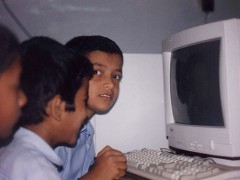ICT and Education in India

No doubt the issue raised by Maria Farooq in Defending the Global Village is very pertinent to India. The chronology of events over the last fourteen years shows it clearly- ICT has been used as a tool for numerous terrorist attacks. But I couldn’t agree more that despite the fact that ICT has aided terrorism, we cannot afford to overlook the highly beneficial contribution it has made to school education.
Over the past two decades information and communication technology has transformed our lives here in India immensely. From communicating with our families and friends all over the world, networking, jobs, film making, and discussion forums to banking, shopping, medical advice and help – there’s simply no limit.The popularity and usefulness of e-learning cannot be overrated and it’s a very well known fact that ICT has been used to enhance learning and improve creativity especially in classrooms in urban areas.

Children learning computer skills at a school in Goa.Image courtesy of Wikimedia Commons. By Frederick "FN" Noronha
There is a growing trend to apply ICT based technologies in schools and other educational institutions. Many schools have dynamic and vibrant virtual learning methods which gives students access to study materials, skills questions, sample papers and assignments. Some schools even have smart interactive white boards for teaching. Children find it more interesting and become more adept in multimedia presentations when engaging with them in their assignments. Quite a percentage (24%) of schools in India use Open Distance Learning. Teachers and students both claim that ICT-enabled learning is more interesting, interactive and keeps students hooked. Assignments are also accepted via email in many schools.
Nevertheless, the parents of a twelve year old girl complained that information based technology – especially TV, the internet and smart phones – were making kids lose their imagination as they became obsessed with these gadgets. “They have no time to read and keep demanding these expensive gifts from parents. If you don’t give it to them you feel you are letting them miss out on opportunities to learn enough as ICT is a true source of information if used prudently. But if you do, kids can go on the rampage on the net and be exposed to harmful stuff like stalking, cyber bullying, harassment, violence, porn, etc,” said Harish. His daughter, however, has a different viewpoint. She said that the internet and other ICT makes it more interesting for her and easier to find a lot of study material that helps her in her school work. “Even my school allows students to access the internet”, she said. But this of course is allowed only at particular times which are monitored by the schools.
One might point out that the vast majority of schools are government-run and only a few privileged, private, international and world schools have much more ample access to ICT. However in recent years even government schools like the Kendriya Vidyalayas have been given access to ICT for educational purposes. The importance of using ICT for improving education has been emphasized in the policy framework for over a decade now in India. Numerous initiatives have been started by both public and private entities. One notable example of a public-private partnership is the Intel Education Initiative. India is working towards the broad use of computer-aided learning in such schools through the Intel® Teach Program. The program covers schools associated with the central Government and various state Governments.
Unfortunately, despite all the progress made, access to ICT for education in rural areas – usually the less developed areas in India – is much less widespread and beneficiaries are almost always not the poorest or most disadvantaged groups. This is always the case in developing countries. Inadequate schools and teachers, expensive infrastructures, untrained human resources, non-sustainability and ineffective monitoring are some of the reasons behind this.
Since education basically is a main motor of social change and reform we need to embrace all we have and find more innovative and better ways for information and technology-enabled learning. But sadly while doing so we might have to encounter various obstacles. Technology does come with its own ‘baggage”. I guess it’s the price you pay for the life you choose. But we have to admit it- technology has undeniably made our lives more easy.
